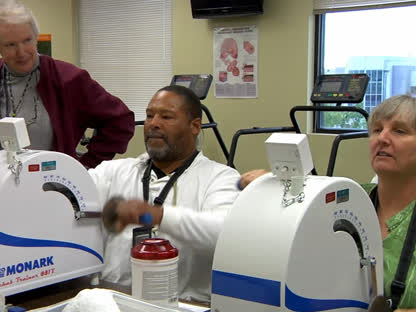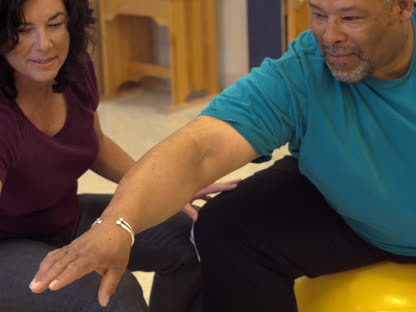Physical Therapy
Condition Basics
What is physical therapy?
Physical therapy is a type of treatment you may need when health problems make it hard to move around and do everyday tasks. It helps you move better and may relieve pain. It also helps improve or restore your physical function and your fitness level.
The goal of physical therapy is to make daily tasks and activities easier. For example, it may help with walking, going up stairs, or getting in and out of bed.
Physical therapy can help with recovery after some surgeries. Your doctor may suggest physical therapy for injuries or long-term health problems such as arthritis or chronic obstructive pulmonary disease (COPD).
Physical therapy may be used alone or with other treatments.
What does a physical therapist do?
Your physical therapist will examine you and talk to you about your symptoms and your daily activity. Your therapist will then work with you on a treatment plan. The goals are to help your joints move better and to restore or increase your flexibility, strength, endurance, coordination, and/or balance.
First, your therapist will try to reduce your pain and swelling. Your physical therapist also may use manual therapy, education, and techniques such as heat, cold, water, ultrasound, and electrical stimulation.
Physical therapy almost always includes exercise. It can include stretching, core exercises, weight lifting, and walking. Your physical therapist may teach you an exercise program so you can do it at home.
Treatment may cause mild soreness or swelling. This is normal, but talk to your physical therapist if it bothers you.
What should you look for in a physical therapist?
You'll want a therapist who has experience with your health problem. Some physical therapists are board-certified in areas such as orthopedics, sports, and neurology and may offer more specialized care. Physical therapists can also specialize in certain types of care, such as:
- Back and neck pain.
- Cardiac rehabilitation (rehab).
- Wound care.
- Cancer-related problems.
- Treatment of children or older adults.
Here are some questions to think about before you choose a physical therapist:
- Can your doctor suggest one?
- Do you need a referral from your doctor? Some states require this.
- Will your insurance company pay for your physical therapy?
Health Tools
Health Tools help you make wise health decisions or take action to improve your health.
Types of Physical Therapy
Exercise
Physical therapy nearly always involves exercise of some kind that is specifically designed for your injury, illness, condition, or to help prevent future health problems.
Exercise is anything you do in addition to your regular daily activity that will improve your flexibility, strength, coordination, or endurance. It even includes changing how you do your regular activities to give you some health benefits. For example, if you park a little farther away from the door of the grocery store, the extra distance you walk is exercise. Also, exercise can include stretching to reduce stress on joints, core stability exercises to strengthen the muscles of your trunk (your back and abdomen) and hips, lifting weights to strengthen muscles, walking, doing water aerobics, and many other forms of activity. Your physical therapist is likely to teach you how to do an exercise program on your own at home so you can continue to work toward your fitness goals and prevent future problems.
Manual therapy
Manual therapy (sometimes called bodywork) is a general term for treatment performed mostly with the hands. The goals of manual therapy include relaxation, decreased pain, and increased flexibility.
Manual therapy can include:
- Massage. Pressure is applied to the soft tissues of the body, such as the muscles. Massage can help relax muscles, increase circulation, and ease pain in the soft tissues.
- Mobilization. Slow, measured movements are used to twist, pull, or push bones and joints into position. This can help loosen tight tissues around a joint and help with flexibility and alignment.
- Manipulation. Pressure is applied to a joint. It can be done with the hands or a special device. The careful, controlled force used on the joint can range from gentle to strong and from slow to rapid.
Education
Physical therapy almost always includes education and training in areas such as:
- Performing your daily tasks safely.
- Protecting your joints and avoiding re-injury.
- Using assistive devices such as crutches or wheelchairs.
- Doing home exercises designed to help with your injury or condition.
- Making your home safe for you if you have strength, balance, or vision problems.
Specialized treatments
In some locations, physical therapists are specially trained to be involved in other types of treatment, including:
- Vestibular rehabilitation, which helps your inner ear respond to changes in your body position. This is helpful if you have problems with vertigo, or a feeling that you or your surroundings are spinning or tilting when there is actually no movement. Rehabilitation (rehab) can help you get used to the problem so you know when to expect it. And rehab can train your body to know how to react.
- Wound care. Wounds that are very severe or don't heal well, often because of poor blood flow to the area, can require extensive care. This may include special cleaning and bandaging on a regular and long-term basis. Sometimes oxygen treatment or electrical stimulation is part of the treatment.
- Pelvic health. Physical therapists can provide instruction in exercises to help control urinary incontinence or to relieve pelvic pain.
- Oncology (cancer care), to help if cancer or treatment for cancer causes you to have problems with movement.
- Decongestive lymphatic drainage, which is a special form of massage to help reduce swelling when the lymph system is not properly draining fluids from your tissues.
Other treatments
Other treatments include:
- Cold and ice, to relieve pain, swelling, and inflammation from injuries and other conditions such as arthritis. Ice can be used for up to 20 minutes at a time. In some cases, ice may be used several times a day. Some therapists also use cooling lotions or sprays.
- Heat, to help relax and heal your muscles and soft tissues by increasing blood circulation. This can be especially helpful if a joint is stiff from osteoarthritis or from being immobilized. Heat can also relax the muscles before exercise. But heat can also increase swelling in an injured area if it is used too soon.
- Ultrasound therapy, which uses high-pitched sound waves to ease muscle spasms and relax and warm muscles before exercise, to help relieve pain and inflammation, and to promote healing.
- Electrical stimulation. In general, this is the use of electrical current to create an effect in the body. Electrical stimulation is sometimes used at low levels to reduce the feeling of pain. It can also be used to cause muscles to contract (tense). And it is being studied as a way to help with healing of wounds and broken bones.
- Hydrotherapy (water therapy), which is a term from the past that means the use of water to treat a disease or to maintain health. The most common hydrotherapy now is water exercise.
Learn more
- Bodywork
- Chiropractic
- Exercise and Physical Activity Ideas
- Fitness: Increasing Core Stability
- Getting Started With Flexibility and Stretching
- Healthy Muscles
- Hydrotherapy
- Kegel Exercises
- Massage Therapy
- Spinal Manipulation
- Transcutaneous Electrical Nerve Stimulation (TENS)
- Using Cold and Heat Therapies
- Water Exercise
When Physical Therapy Can Help
Physical therapy and recovery from injury
Physical therapy can help you recover from an injury and avoid future injury. Your physical therapist can help you reduce pain in the soft tissues (muscles, tendons, and ligaments), build muscle strength, and improve flexibility, function, and range of motion. They can also evaluate how you do an activity and make suggestions for doing the activity in a way that is less likely to result in an injury.
Physical therapy and chronic health conditions
Physical therapy can help you live more easily with chronic or ongoing health conditions such as spinal stenosis, arthritis, and Parkinson's disease. Your physical therapist will work with you to establish your goals. Then they will create a program of educational, range-of-motion, strengthening, and endurance activities to meet your needs.
Physical therapy and health conditions requiring a rehabilitation team approach
Some conditions involve several body systems and can lead to significant disability. These conditions—such as stroke, spinal cord injury, and major cardiopulmonary (heart and lung) problems—are usually addressed by a team of health professionals through programs such as cardiac rehab and stroke rehab. The team can include doctors; nurses; physical, occupational, and speech therapists; psychologists; and social workers, among others.
Physical therapists are a critical part of this team. They address the issues of range of motion, strength, endurance, mobility (walking, going up and down stairs, getting in and out of a bed or chair), and safety. The physical therapist may also get you the equipment you need, such as a walker or wheelchair, and make sure you can use the equipment appropriately.
Physical therapy and significant health conditions of childhood
Physical therapists also work with children who have major injuries or health conditions, such as cerebral palsy. They address the usual issues of range of motion, strength, endurance, and mobility. Also, the therapist considers the child's special growth and developmental needs.
Treatment is often provided in the school or in a facility just for children. The way physical therapy and other services are delivered in the schools varies among the states. Talk to your child's doctor, school, or your local health department if you think your child may qualify for evaluation or treatment services.
Learn more
Watch
Credits
Current as of: October 24, 2024
Author: Ignite Healthwise, LLC Staff
Clinical Review Board
All Ignite Healthwise, LLC education is reviewed by a team that includes physicians, nurses, advanced practitioners, registered dieticians, and other healthcare professionals.
Current as of: October 24, 2024
Author: Ignite Healthwise, LLC Staff
Clinical Review Board
All Ignite Healthwise, LLC education is reviewed by a team that includes physicians, nurses, advanced practitioners, registered dieticians, and other healthcare professionals.



